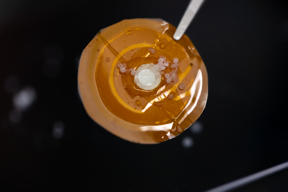Home > Press > Taking salt out of the water equation
 |
| KAUST researchers have developed a membrane (pictured above) with excellent water desalination performance in forward and reverse osmosis configurations.
CREDIT © 2022 KAUST; Anastasia Serin. |
Abstract:
Ultrathin polymer-based ordered membranes that effectively remove salt from seawater and brine could provide a promising alternative to existing water desalination systems, a KAUST-led team demonstrates.
Taking salt out of the water equation
Thuwal, Saudi Arabia | Posted on October 7th, 2022
One way to address these limitations is through two-dimensional porous carbonaceous membranes with regular and uniformly distributed subnanometer-sized molecular transport channels, says first author Jie Shen, a postdoc in Hans group. However, these membranes are typically synthesized in solution, which promotes the random growth of a disordered three-dimensional structure with poorly defined micropores.
Yu Han, Vincent Tung, Ingo Pinnau and former KAUST scientist Lance Li, who is now at the University of Hong Kong, have developed a method that helps control the growth of two-dimensional conjugated polymer frameworks into ultrathin carbon films using chemical vapor deposition.
The researchers deposited the monomer triethynylbenzene on atomically flat single-crystalline copper substrates in the presence of an organic base that acts as a catalyst. Triethynylbenzene bears three reactive groups that serve as anchor points for additional monomers. These groups show a 120-degree angle with respect to each other, generating organized arrays of well-defined cyclic structures that stack into subnanometer-sized rhombic hydrophobic channels.
The membrane displayed excellent water desalination performance in forward and reverse osmosis configurations, surpassing those containing advanced materials such as carbon nanotubes and graphene. It also showed strong rejection for divalent ions, as well as small charged and neutral molecules.
The researchers discovered that the water molecules formed a three-dimensional network inside the membrane instead of moving through the membrane along vertical triangular channels as one-dimensional chains. This explains the fast water transport through the membrane. This unexpected result revealed that the seemingly discrete vertical channels are actually interconnected by short horizontal channels that can be easily overlooked in the projected structural model, Han says.
The team is now working on improving the antifouling property, mechanical strength and long-term chemical stability of the membrane for future practical applications. They are also fine-tuning its surface-charge properties and channel sizes. Our ultimate goal is to provide a versatile multifunctional platform that meets the needs of various applications, such as ion sieving, single-molecule sensing and neural interfaces, Han says.
####
For more information, please click here
Contacts:
Media Contact
Michael Cusack
King Abdullah University of Science & Technology (KAUST)
Office: 009660128083040
Expert Contact
Yu Han
King Abdullah University of Science and Technology
Copyright © King Abdullah University of Science & Technology (KAUST)
If you have a comment, please Contact us.
Issuers of news releases, not 7th Wave, Inc. or Nanotechnology Now, are solely responsible for the accuracy of the content.
News and information
![]()
Disposable electronics on a simple sheet of paper October 7th, 2022
![]()
The battery that runs 630 km on a single charge October 7th, 2022
Brain-Computer Interfaces
![]()
New brain-like computing device simulates human learning: Researchers conditioned device to learn by association, like Pavlov’s dog April 30th, 2021
![]()
Gentle probes could enable massive brain data collection: National Institutes of Health backing Rices Chong Xie to refine flexible nanoelectronics thread September 14th, 2020
Possible Futures
![]()
Underwater movement sensor alerts when a swimmer might be drowning October 7th, 2022
![]()
NISTs superconducting hardware could scale up brain-inspired computing October 7th, 2022
Sensors
![]()
Silicon image sensor that computes: Device speeds up, simplifies image processing for autonomous vehicles and other applications August 26th, 2022
![]()
Life-like lasers can self-organise, adapt their structure, and cooperate July 15th, 2022
Discoveries
![]()
Disposable electronics on a simple sheet of paper October 7th, 2022
![]()
The battery that runs 630 km on a single charge October 7th, 2022
Announcements
![]()
Disposable electronics on a simple sheet of paper October 7th, 2022
![]()
The battery that runs 630 km on a single charge October 7th, 2022
Interviews/Book Reviews/Essays/Reports/Podcasts/Journals/White papers/Posters
![]()
Disposable electronics on a simple sheet of paper October 7th, 2022
![]()
The battery that runs 630 km on a single charge October 7th, 2022
Water
![]()
Scientists offer solutions for risky tap water June 17th, 2022
![]()
UBCO researchers change the game when it comes to activity tracking: Flexible, highly sensitive motion device created by extrusion printing June 17th, 2022
![]()
Organic water splitters get a boost June 10th, 2022










